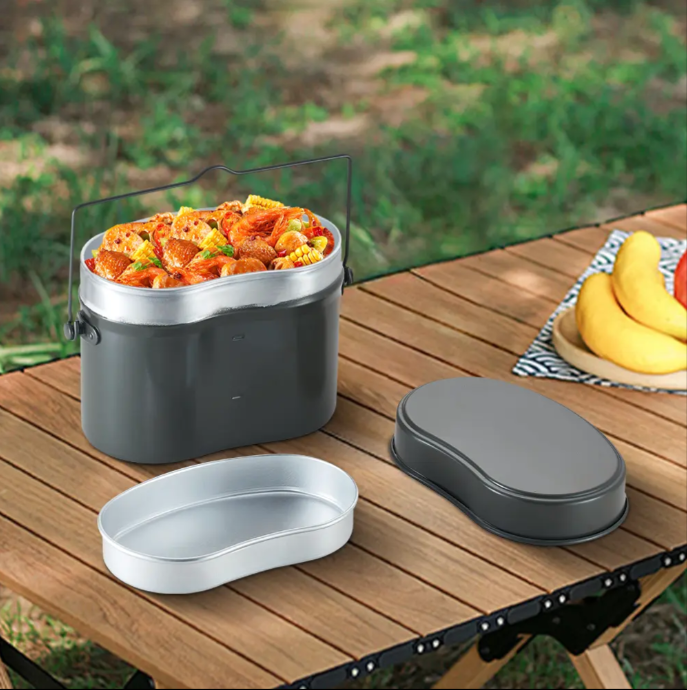Ჭურჭლის ყუთის მიდევნება: რას უნდა გაითვალისწინონ ყიდვის დროს?
Სამხედრო სტანდარტის საჭმლის ჭურჭლის გაგება ბუნების მოყვარულებისთვის
Როდესაც საუბარი მიდის გარე სივრცეში სამზადმზადო და საჭმლის მიღების აღჭურჭლაზე, სამხედრო თეფში საჭმლის უდი დაიკავა თავისი ადგილი პიროვნებისაგან დაწყებული ყოველდღიურად კემპინგის მოყვარულებამდე. ეს კომპაქტური, მდგრადი კონტეინერები განვითარდა სამხედრო წარმოშობიდან და გახდა მრავალმხრივი ინსტრუმენტები, რომლებიც სარგებლობენ რამდენიმე მიზნით გარე სივრცეში. მიუხედავად იმისა, რომ თქვენ აპირებთ კვირის ბოლოს კემპინგის მოგზაურობას თუ ამზადებთ თქვენს სიცოცხლის შესანარჩუნებელ კიტს, სწორი სამხედრო თეფშის არჩევა მნიშვნელოვნად შეძლებს გააუმჯობინოს თქვენი გარე სივრცეში საჭმლის მიღების გამოცდილება.
Ხარისხიანი მეს თეფშების ძირეული თვისებები
Მასალის საშუალება და მდებარეობა
Ნებისმიერი სანდო მეს თეფშის საფუძველი მდებარეობს მის შემადგენელ მასალაში. მაღალი ხარისხის ღირო ფოლადი რჩება ყველაზე პოპულარულ არჩევანად, რომეიც გვთავაზობს გამძლეობის და ჟანგის წინააღმდეგობის საუკეთესო მაჩვენებლებს. ალუმინის ვარიანტები უფრო მსუბუქ ალტერნატივას წარმოადგენს, მაგრამ შეიძლება ვერ მიაღწიოს ღირო ფოლადის ანალოგების სიგრძეს. როდესაც მეს თეფშის სხვადასხვა ვარიანტს შეხვალთ, ყურადღებით შეამოწმეთ მასალის სისქე და შეერთების ზოლებზე შედუღების ხარისხი.
Ზომა და შენახვის მოცულობა
Კარგად შემუშავებულ სამზადო თეფშს უნდა ჰქონდეს საკმარისი ტევადობა, რომ არ შეუქმნას პრობლემა გადატანისას. სტანდარტული ზომები ჩვეულებრივ 500 მლ-დან 1000 მლ-მდე ვარირებს, ზოგიერთ მოდელს კი სტეკირებადი კონსტრუქცია აქვს ეფექტური შენახვისთვის. გაითვალისწინეთ თქვენი ჩვეულებრივი კერძის პორციები და ის, სჭირდება თუ არა რამდენიმე ინგრედიენტის ერთდროულად გაცხელება. ბევრი საგარეო აქტივობის მოყვარული ირჩევს ორი თეფშის კომპლექტს – ერთს სამზადოდ და მეორეს საჭმლად.
Სითბოს განაწილების თვისებები
Სამზადო თეფშის ეფექტურობა მზადობის დროს დიდწილად დამოკიდებულია მის სითბოს განაწილების შესაძლებლობაზე. ხარისხიან სამზადო თეფშებს აქვთ ფსკერი, რომელიც უზრუნველყოფს სითბოს თანაბარ განაწილებას და ახშობს ცალკეული ადგილების გადაცხელებას, რაც შეიძლება საკვების დაწვას გამოიწვიოს. მიაქციეთ ყურადღება მოდელებს უფრო სქელი ფსკერით, რადგან ისინი უკეთ მუშაობენ ბაღის ცეცხლზე და პორტატიულ გამათბობლებზე.

Კონსტრუქციის ისეთი ელემენტები, რომლებიც ზეგავლენას ახდენენ მუშაობაზე
Მართვის მექანიზმი
Საკვების ყუთის ხელმოქმედის დიზაინს მნიშვნელოვანი როლი აქვს მის ფუნქციონალურობაში. სახურავის ხელმოქმედები უნდა იქნებოდეს მყარად დაბლოკილი, როგორც გაშლილ, ასევე შეკუმშულ მდგომარეობაში, ხოლო სიგრძე უნდა იყოს საკმარისი უსაფრთხოდ მართვისთვის ცხელ მდგომარეობაში. ზოგიერთ პრემიუმ საკვების ყუთზე ხელმოქმედები აღჭურვილია სითბოს წინააღმდეგობის საფარით ან იზოლირებული უბნებით, რაც გამოყენების დროს დამატებით უსაფრთხოებას უზრუნველყოფს.
Ჩადგმის და მობილურობის თვისებები
Ახალგაზრდა საკვების ყუთების დიზაინი ხშირად ირგვლივ იქმნება გასაგები ჩადგმის თვისებებით, რომლებიც საშუალებას აძლევს რამდენიმე ნაწილს ერთმანეთზე დადგეს, რაც ზურგჩანთის ფარგლებში მნიშვნელოვან სივრცეს ზოგავს. მიაქციეთ ყურადღება იმ მოდელებს, რომლებზეც არის უხეში წიბოები და კუთხეები, რომლებიც არ ეხებიან სხვა ინვენტარს და არ ქმნიან ხელშეუშლელ წერტილებს თქვენს ზურგჩანთაში. ზოგიერთი წარმოებელი შიდა მხარეს აგდებს ზომის ნიშნულებს, რაც ზუსტი მომზადებისთვის დამატებით სარგებლობას უზრუნველყოფს.
Სახურავის ფუნქციონალურობა
Კარგად შემუშავებული სახურავი შეიძლება გადააქციოს მარტივი ჭურჭელი მრავალფუნქციურ სამზადებლად. ზოგიერთი სახურავი ასევე შეიძლება გამოყენებულ იქნას როგორც საცხობი თასი ან თეფში, ხოლო სხვებზე არის სადიდების ღიობები, რათა უფრო კონტროლირებადად მოხდეს სამზადებლო პროცესი. სახურავმა უნდა უზრუნველყოს მყარი დახურვა, რათა არ მოხდეს გადა spills ტრანსპორტირების დროს, მაგრამ იგივე დროს იყოს მარტივად მოშორებადი საჭიროების შემთხვევაში.
Პრაქტიკული გამოყენება და მრავალფეროვნება
Სამზადებლო შესაძლებლობები
Საუკეთესო ჭურჭლები გამოირჩევიან სხვადასხვა სამზადებლო ვარიანტში, მარტივი გაცხელებიდან დაწყებული უფრო რთული კერძების მომზადებით დამთავრებული. გაითვალისწინეთ, თუ როგორ გამოიყენებთ თქვენს ჭურჭელს – წყლის დახურვისთვის, დეჰიდრატირებული კერძების მოსამზადებლად თუ საჭმლის მომზადებისთვის. ზოგიერთ მოდელზე შიდა მხარეს არის ნიშნულები, რაც განსაკუთრებით სასარგებლოა ზუსტი სამზადებლო მოთხოვნებისთვის.
Მოხუცვა და შესარჩევი
Სწორი მოვლა უზრუნველყოფს თქვენი ჭიქის ინვესტიციის გამძლეობას. მიაქციეთ ყურადღება დიზაინს, რომელიც მომრგვალო კუთხეებით არის დამზადებული და ამით თავიდან არიდებს საკვების გაჭედვას და გასუფთავებას ამარტივებს. არადამჭიმავი საფარი შეიძლება იყოს სასარგებლო, მაგრამ მისი დაზიანების თავიდან ასაცილებლად საჭიროა ფრთხილად მოვლა. გაითვალისწინეთ, შეიძლება თუ არა ჭიქა ისაფლავოთ სამრეცხაო მანქანაში, რათა მოგვიანებით მოგვარიდოს დრო გარე თავგადასავლებიდან დაბრუნების შემდეგ.
Გარემოს განსაზღვრება და მართვა
Მასალის ზემოქმედება
Ჭიქის შერჩევისას გაითვალისწინეთ მისი გავლენა გარემოზე. უჟანგავი ფოლადის ვარიანტებს ჩვეულებრივ უმჯობესი კომბინაცია აქვთ მაღალი გამძლეობისა და გარემოს დამეგობრების მხრივ, რადგან ისინი რამდენიმე წელიწადიანი გამოყენების შემდეგაც კი შეიძლება გამოდგენილიყვნენ და სრულად გადამუშავდებოდნენ. ზოგიერთი წარმოებელი ახლა ჭიქებს გადამუშავებული მასალებისგან ამზადებს, რაც კიდევ უფრო ამცირებს მათ გარემოზე გავლენას და მაღალი სიმძლავრის სტანდარტების შენარჩუნებას უზრუნველყოფს.
Გამძლეობა და ჩანაცვლების ციკლები
Ხშირად მტკიცდება, რომ ხარისხიან ჭურჭელზე ინვესტიცია უფრო მდგრადია, ვიდრე იეფი ალტერნატივების ყიდვა, რომლებიც ხშირად საჭიროებს ჩანაცვლებას. გაითვალისწინეთ წარმოებლის გარანტია და რეპუტაცია მაღალი ხანგრძლივობის საგარე საწყობების წარმოებაში. კარგად შენახული ჭურჭელი უნდა უზრუნველყოს საიმედო მომსახურებით ბევრი წლის განმავლობაში საგარე თავგადასავლების დროს.
Ხშირად დასმული კითხვები
Როგორ შემიძლია ჭურჭლის ჟანგვის თავიდან აცილება?
Ჟანგის თავიდან ასაცილებლად, თითოეული გამოყენების შემდეგ კარგად გააშროეთ თქვენი ჭურჭელი და შეინახეთ კარგად შენახულ ადგილას. დროდადრო მოახვევინეთ ზედაპირზე მსუბუქი სამზადო ზეთი და არ ინახოთ ჭურჭელში საკვები გრძელი პერიოდის განმავლობაში. უჟანგავი ფოლადის მოდელების შემთხვევაში, დარწმუნდით, რომ იყენებთ შესაბამის სასუფთავებელ საშუალებებს, რომლებიც არ დაზიანებს დამცავ ფენას.
Შეიძლება თუ არა ჭურჭლის პირდაპირ ბადეზე გამოყენება?
Უმეტესი ხარისხიანი სამზადო თეფშები შეიძლება პირდაპირ გამოყენებულ იქნას კერის მთავანზე, მაგრამ მნიშვნელოვანია სითბოს ზემოქმედების მართვა. გამოიყენეთ სტაბილური მხარდაჭერის სისტემა და თავიდან აიცილეთ თეფშის პირდაპირ ალზე დადება. დამუშავებული ფოლადის მოდელები ჩვეულებრივ უკეთ გადაჰყვებიან პირდაპირ სითბოს, ვიდრე ალუმინის ალტერნატივები.
Რა ზომის სამზადო თეფშია საუკეთესო პირადი გამოყენებისთვის?
Ინდივიდუალური გამოყენებისთვის 750მლ-იანი სამზადო თეფში ჩვეულებრივ საკმარის ადგილს უზრუნველყოფს უმეტესი სადილისთვის, ხოლო მაინც რჩება მობილური. განიხილეთ საშენი ნაკრების შეძენა ორი სხვადასხვა ზომით – უფრო დიდი მზადობისთვის და უფრო პატარა ჭამის ან გვერდითი კერძების გასათბობად.
 EN
EN
 AR
AR
 BG
BG
 HR
HR
 CS
CS
 DA
DA
 NL
NL
 FI
FI
 FR
FR
 DE
DE
 EL
EL
 IT
IT
 JA
JA
 KO
KO
 NO
NO
 PL
PL
 PT
PT
 RO
RO
 RU
RU
 ES
ES
 SV
SV
 TL
TL
 IW
IW
 ID
ID
 SR
SR
 SK
SK
 UK
UK
 VI
VI
 SQ
SQ
 HU
HU
 TH
TH
 TR
TR
 MS
MS
 GA
GA
 CY
CY
 IS
IS
 HY
HY
 AZ
AZ
 KA
KA

